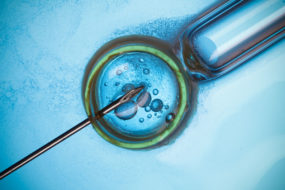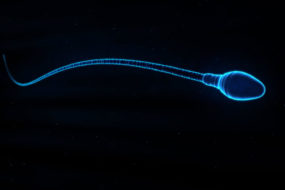In the normal menstrual cycle, several follicles (little sacs of fluid each containing one egg) begin to grow within the ovary, but only grows large enough to release an egg (ovulation). By giving hormone treatment, it is possible to make many follicles grow at the same time. This treatment takes the form of a nasal spray/injection, followed by a course of injections and as result, an average of 5 – 10 follicles should mature. In each treatment cycle you will attend the C.A.R.E Clinic shortly before you commence the nasal spray to discuss the treatment schedule and to ask any questions that you may have about the procedure. Sometimes the ovaries are non-responsive to the hormone stimulation. In those cases Dr. Ramdeo may decide to abort the cycle and restart at a later stage.
IVF & ICSI
In Vitro Fertilization (IVF) Overview
In Vitro Fertilization (IVF) Processes
-
1. Ovarian Stimulation
-
2. Follicle Development
Monitoring of follicle development is performed by ultrasound scanning and hormonal profiles. The clearest picture of the ovaries is obtained by using a small ultrasound probe placed in the vagina. The scan is performed from day 8 to check the number and size of the follicles and may be repeated 2 days later, if necessary. If there has been a good response, then HCG (Human Chorionic Gonadotrophin) is given to mature and release the eggs. Egg collection is then carried out 36 hours later when the lead follicle is +/- 18mm. Occasionally the response to the injection is greater than anticipated – “Hyper stimulation” – and a very large number (>10) of eggs may be produced. Should pregnancy occur in this treatment cycle, the hormones produced by the tiny placenta, are sufficient to cause the ovaries to swell considerably over the following 2-3 weeks. This causes swelling of the lower abdomen. “Hyper stimulation Syndrome” can be very painful, requiring hospital admission. Sometimes embryos/eggs need to be frozen and transferred in a later cycle.
-
3. Egg Recovery
Egg recovery is performed at the C.A.R.E Clinic under conscious sedation. Eggs are recovered by ultrasound monitoring of each follicle transvaginally. Not every follicle will yield an egg. The procedure may vary from 20 minutes to 1 hour.
A small amount of vaginal bleeding can occur up to a day after egg recovery and some discomfort in the lower abdomen may persist for 12-24 hours. Infection results in less than 1:300. Should this happen, pain in the lower abdomen and a raise temperature may be noticed in the days following the procedure. Antibiotic treatment is usually adequate to clear this infection. This is given routinely (orally).
-
4. Fertilization
Following a successful egg recovery, the eggs are placed in a culture media in an incubator and the semen is then required. The sample should be produced at the Clinic, as fresh sperm gives the best results. Should it be necessary to produce the sample at home special arrangements can be made, provided the Clinic staff are informed well in advance. In the laboratory the semen is concentrated and healthy sperm are separated so that 50 – 100 000 sperm are added to each egg to allow fertilization to occur. Not every egg will fertilize nor is it possible to predict which ones will, so sperm are added to all the eggs that have been harvested.
Fertilization usually takes 16 – 24 hours and it is recognised by the characteristic changes in the egg that can be microscopically identified by the embryologist. Should fertilization not occur during the treatment cycle, embryo transfer can not be carried out.
-
5. Embryo Transfer
The fertilized eggs (embryos) are grown in the laboratory for between 2 – 5 days until they are ready for transfer into the uterus. They are placed in the uterine cavity by passing a small plastic tube through the cervix. This procedure is similar to having a cervical smear taken; it is a simple painless procedure and takes only a few minutes to perform.
-
Who Needs In Vitro Fertilization (IVF)?
A woman who has blocked Fallopian tubes (which means that the egg and sperm cannot meet naturally) or whose tubes are damaged to such an extent that surgery would not improve the situation. In Vitro Fertilization (IVF) may also be of help to couples where the problem is endometriosis, polycystic ovarian syndrome and unexplained infertility.
-
How is In Vitro Fertilization (IVF) carried out?
After the initial consultation and discussion about all aspects of IVF, the treatment can be divided into five stages:
- Ovarian Stimulation
- Monitoring the follicle development
- Egg Recovery
- Fertilization and embryo culture
- Embryo transfer
-
Are all embryos transferred?
Only embryos that have been carefully checked and appear to be developing normally are replaced. A maximum of 3 embryos will be transferred.
A freezing facility is available at the C.A.R.E Clinic. This process will ensure that any good quality embryos can be stored for future cycles avoiding the whole programme of hormone stimulation. This may be done in a natural cycle or a prepared cycle.
-
What happens after embryo transfer?
Bed rest is not required but strenuous exercise and sexual intercourse is not advisable during the following 14 days. Smoking, alcohol and all other drugs should be avoided.
-
Is there a risk of miscarriage?
All pregnancies carry a risk of miscarriage, but it is slightly higher in less fertile couples.
-
What happens if I have an ectopic pregnancy?
An ectopic pregnancy is when the embryo develops outside the endometrium i.e. the tubes. It is rare, can be painful and in most cases might have to be terminated.
-
Does IVF increase the chance of Foetal abnormality?
Numerous babies have been born following this treatment and no increase in the number of abnormalities has been found.
-
What happens if IVF has been successful?
14 days after embryo transfer blood tests are carried out at the C.A.R.E Clinic. If positive, a scan is performed two weeks later to check for a gestational sac and foetal echoes.
-
What if IVF is unsuccessful?
To allow complete recovery, an interval period of 1 – 2 months is necessary before embarking on another cycle of treatment. This period permits the ovaries to return to normal and allows a full recovery from the stress of the treatment. The number of cycles that should be undertaken will differ for each couple but will be decided after a discussion with Dr Ramdeo.
Overview Of Intracytoplasmic Sperm Injection (ICSI)

C.A.R.E Clinic will conduct testing for eligibility. It is suitable for patients with spinal cord injuries. Here, sperm is extracted and frozen (local anesthetic or sedation).

It is indicated for patients undergoing prenatal genetic screening array CGH – see array CGH (the first in Africa and South Africa)
Book Initial Consultation, Call +27 (031) 267-7920
Fees are an estimate only and may be more depending on your situation
- CONTACT US TODAY





